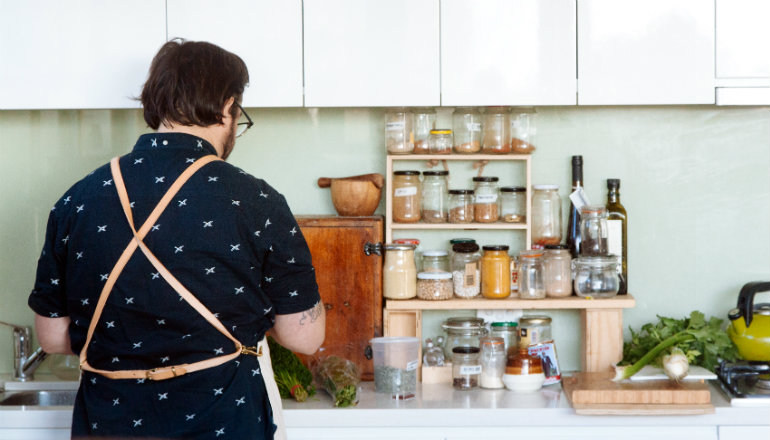
Giving a hard check to what you put in your body is one of the most enlightening and challenging aspects of the Whole Life Challenge. Reading ingredients, asking questions in restaurants, looking suspiciously at salad bars — it’s all part of the fun.
You discover that the best way to know what’s on your plate is to put it there yourself. But that means getting in the kitchen, which can be a scary proposition for some of us.
This eight-part series is designed to empower you in the kitchen so you can dominate at cooking and prepare meals that are exactly right for you. Each week we will focus on a new skill, technique or strategy to increase your confidence, efficiency, and creativity with meal preparation.

Week 1: The 5 Moves
In this first lesson we are focusing on the one thing you absolutely must have to succeed at cooking: chef sense. Chef sense is what guides you through the process of taking raw ingredients and turning them into delicious meals. It allows you to cook by eye, feel, and smell.
Sounds great, but what if you don’t have any chef sense?
Well, then, you’re like I used to be in the kitchen. My only move was following directions on a box. And even that was hit or miss. I didn’t grow up in a household where cooking was a part of life, so I never learned the basics of preparing a meal from scratch.

If you’ve ever looked for help with cooking you probably encountered the same difficulties I did. The people who teach cooking assume you want to be a restaurant chef or you already know enough to follow their recipes.
So I taught myself to cook and eventually developed a system to make fifteen different homemade meals in only two hours.
I dubbed the method Kitchen Karate and offered to teach it to people out of a test kitchen in Los Angeles. And the people came. Over a thousand students later I am convinced that learning to cook (not following recipes) is one of the most empowering thing you can do for yourself.
The good news is that cooking is actually quite simple. There are only five moves, and I’m going to teach them to you right now. The best way to learn “The 5 Moves” is to do them, so get ready to jump in with both oven mitts and show food who’s boss!

Move #1: Shop
Here’s your shopping list:
- 2 servings vegetable
- 1 serving meat or meat substitute
What’s a serving? Well, your hands are your new measuring devices. Forget cups and grams and ounces. Forget calorie counting. You can determine your correct serving sizes by hand.
- 1 serving vegetable = handful
- 1 serving meat or meat substitute = palm-size piece
Start by shopping your own kitchen first. You might not even have to run to the store to make your first meal. You can use any meat or meat substitute. And there are three main types of vegetables:
- Firm (carrots, cauliflower, yams, etc)
- Soft (tomato, mushrooms, peppers, etc)
- Leafy (lettuce, kale, spinach, etc)
Grab vegetables from the firm and soft categories. Skip the leafy greens for now.

Move #2: Chop
Your Tools:
- 1 knife
- 1 cutting board for produce
- 1 cutting board for meat (should be plastic/non-porous)
- 3 bowls
Instructions:
- Preheat your oven to 400 degrees. Do this at the beginning so the oven is ready when you are.
- Get out your knife and cutting board. We are covering knife skills in lesson two, so for now just use any knife. You can even use scissors if that’s what it takes.
- Cut your vegetables. Always chop plants before meats to avoid cross-contamination. Chop each handful of vegetable down to bite-size pieces, about the width of your finger. Cut them roughly the same width so they cook evenly. If you have both soft and firm veggies, cut your firm veggie to half the size of your soft veggies so they cook through in roughly the same amount of time. Put each chopped vegetable in its own bowl.
- Portion out your meat or meat substitute. Hover your palm over the item to measure out a palm-size piece. Cut that off and place in the third bowl. Put anything left into a storage bag and put back in the refrigerator.
- Wash your hands, knife, and cutting boards.

Move #3: Sprinkle
Your Seasonings:
- Salt
- Pepper
- Fat of choice — olive oil, butter, coconut oil, ghee, etc.
- 1 thing sour — lemon, lime, balsamic vinegar, rice vinegar, etc.
- 1 thing spicy — garlic, onion, cayenne, chili, ginger, etc.
- 1 thing savory — dried or fresh oregano, basil, thyme, rosemary, etc.
Instructions:
- Set up your Sprinkle Station. It’s a good practice to get all your seasonings out before you begin adding any of them to your ingredients. Place your three bowls from Move #2 in the center of your Sprinkle Station.
- Pick each seasoning up once. Sprinkle salt on all three ingredients, then pepper, then oil. Add your sour seasoning on just one of your ingredients. Add your spicy seasoning to a different one. Add your savory seasoning to the remaining ingredients. We are purposefully isolating the added flavor notes so you can truly taste their impact. In later posts we will delve deeper into seasoning and create layers of flavor.
I often get asked how much seasoning should be put on an ingredient. You should be able to see, feel, and smell that your ingredient is well-coated with seasoning. Wondering if you have enough? Then you probably don’t. Most people who don’t trust their chef sense tend to under-season things out of fear of ruining it. I’d rather see you go bold and learn to scale it back than to barely taste what you’ve done.

Move #4: Poke
Instructions:
- Prep for the oven. We’re roasting everything to keep it simple. Your oven should be preheated to 400 by now. Transfer your ingredients to individual oven-safe containers such as Pyrex or CorningWare. You can also just use three sheets of tinfoil and shape them into containers. Keeping the ingredients separated lets you moderate their cooking times independently. Plus, it keeps their seasonings separated.
- Cook for 15 minutes. Put your dishes in your oven and set a timer for 15 minutes. 400 degrees is a strong, but forgiving temperature. 15 minutes is long enough for most items, but rarely overcooks anything.
- Poke vegetables. When the timer goes off, pull the items. Check the vegetables first by poking them with your fork. If the fork goes in easily, they are done. If not, you might give them more time in the oven. Your personal preference is all that matters with vegetables.
- Cut meats. To confirm your meats are safe to eat, cut through the thickest part to check. Chicken and pork should be white all the way through. Fish should not be translucent and should easily break apart with a fork. Red meat can be as red as you like in the middle, but the outside needs to be browned. Most people prefer beef cooked medium-well, which means there is a little band of red in the center, but it’s pink to brown everywhere else.
- Pull the finished items. Chances are everything is done, but if you have a particularly thick cut of meat or thick-cut root vegetables, they might need to go back in for 5 to 15 minutes. Wait until everything is done cooking before advancing to the final move.

Move #5: Plate
Well played, Chef! Now you get to eat the results. This move is where you check your work from the previous four moves:
- Too much or too little food? Your Shop needs adjusting.
- Anything cut up too big or too small? Your Chop needs adjusting.
- Anything taste less than delicious? Your Sprinkle needs adjusting.
- Anything undercooked or overcooked? Your Poke needs adjusting.
Every time you perform The 5 Moves, your chef sense will get stronger. Run this drill a few times between now and taking on lesson number two. Throughout the remainder of this eight-part series you will continue to practice these basic moves to cooking everything as you learn new techniques and strategies to unleash your inner chef.
Ready for more? Dive into the rest of the lessons in this series:
- Knife Skills and Stir Fry: Home Cooking Boot Camp Lesson 2
- The 3 Essential Cooking Methods: Home Cooking Boot Camp Lesson 3
- How to Make Multiple Meals at Once: Home Cooking Boot Camp Lesson 4
- How to Organize Your Kitchen for Speed: Home Cooking Boot Camp Lesson 5
- The Power of Flavor Profiles: Home Cooking Boot Camp Lesson 6
- The Secret Tool of Taste Balancing: Home Cooking Boot Camp Lesson 7
- Learn to Play the 3 Flavor Notes: Home Cooking Boot Camp Lesson 8



































